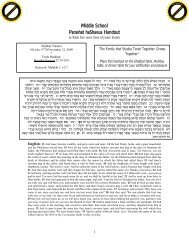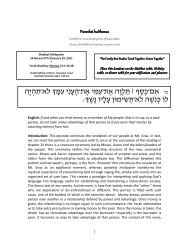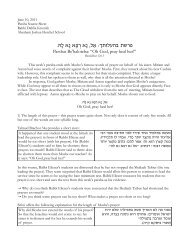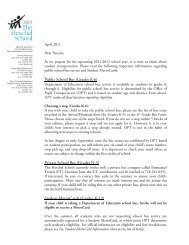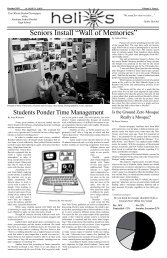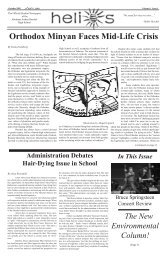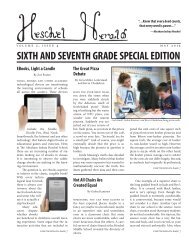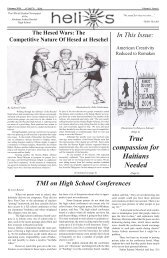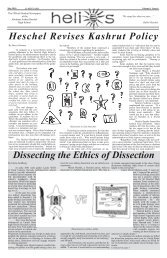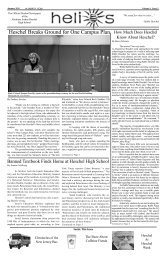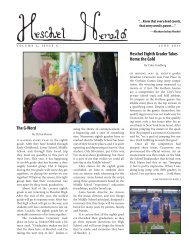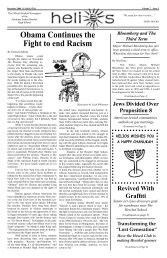Shelah - The Heschel School
Shelah - The Heschel School
Shelah - The Heschel School
Create successful ePaper yourself
Turn your PDF publications into a flip-book with our unique Google optimized e-Paper software.
Middle <strong>School</strong><br />
Parashat haShavua Handout<br />
by Rabbi Dov Lerea, Dean of Judaic Studies<br />
Shabbat Parashat Shelakh lekha<br />
24 Iyyar 5770/June 5, 2010<br />
*<br />
Torah Reading: B’midbar 13:1-15:41<br />
Haftarah: Joshua 2:1-24<br />
***<br />
Candle lighting: 8:05 pm Havdalah Saturday night: 9:13 pm<br />
“<strong>The</strong> Family that Studies Torah Together, Grows Together”<br />
Place this handout on the Shabbat table, Holiday<br />
table, or dinner table for your edification and pleasure<br />
לז וַיֹּאמֶ ר יְ הוֹ ָה אֶ ל־מֹשֶׁ ה לֵּאמֹר דַּ בֵּ ר אֶ ל־בְּ נֵי יִ שְ ֹרָ אֵ ל וְ אָמַ רְ תָּ אֲ לֵהֶ ם וְ עָ שֹוּ לָהֶ ם<br />
צִ יצִ ת עַ ל־כַּנְפֵ י בִ גְ דֵ יהֶ ם לְ דֹרֹתָ ם וְ נָתְ נוּ עַ ל־צִ יצִ ת הַ כָּנָף פְּ תִ יל תְּ כֵלֶת: לט וְ הָ יָה לָכֶם<br />
לְ צִ יצִ ת וּרְ אִ יתֶ ם אֹתוֹ וּזְ כַרְ תֶּ ם אֶ ת־כָּל־מִ צְ וֹת יְ הֹוָה וַעֲשִ ֹיתֶ ם אֹתָ ם וְ א תָ תוּרוּ אַחֲ רֵ י<br />
לְ בַ בְ כֶם וְ אַחֲ רֵ י עֵ ינֵיכֶם אֲ שֶׁ ר־אַ תֶּ ם זֹנִים אַחֲ רֵ יהֶ ם: מ לְ מַ עַ ן תִּ זְ כְּ רוּ וַעֲשִ ֹיתֶ ם<br />
אֶ ת־כָּל־מִ צְ וֹתָ י וִ הְ יִ יתֶ ם קְ דֹשִׁ ים לֵאהֵ יכֶם: מא אֲ נִי יְ הוֹ ָה אֱ הֵ יכֶם אֲ ֶשׁר הוֹצֵ אתִ י<br />
אֶ תְ כֶם מֵ אֶ רֶ ץ מִ צְ רַ יִ ם לִ הְ יוֹת לָכֶם לֵאהִ ים אֲ נִי יְ הוֹ ָה אֱ הֵ יכֶם<br />
:<br />
: לח<br />
English translation: God said to Moses: Speak to the Children of Israel and say to them:<br />
‘Let them fashion fringes on the corners of their garments in every generation, and let<br />
them place a blue thread amongst the fringes of those corners. <strong>The</strong>n, they will have a<br />
tzitzit fringe, and they will see it, and then recall all of God’s mitzvoth and they will act<br />
on them. <strong>The</strong>y will not act impulsively after their heart and eyes, as you are inclined to<br />
do. In this way, you will be constantly aware of and act on My mitzvoth and become holy<br />
[in the eyes of] you God. I am the Lord your God who took you from the Land of Egypt in<br />
order to become your God; I am the Lord your God.’<br />
Introductory remarks <strong>The</strong> parasha can be divided into the following sections:<br />
Part One: <strong>The</strong> Scouting expedition 13:1-14:10<br />
Part Two: God’s response and Moses’ response to God 14:11-25<br />
Part Three: <strong>The</strong> consequences for the first generation 14:26-45<br />
Part Four: Interlude:<br />
a. Free-will offerings for vows 15:1-16<br />
b. Challah offerings for bread 15:17-21<br />
c. Offering for communal error 15:22-26<br />
d. Offering for individual error 15:27-31<br />
e. <strong>The</strong> Wood-gatherer 15:32-36<br />
Part Five: <strong>The</strong> mitzvah of wearing tzitzit 15:37-41<br />
<strong>The</strong> first three parts and the last (“fifth”) part form a literary unit, orgasnized around the<br />
same key words. <strong>The</strong> motif-words of the scouting expedition are “scouting”/taturu/tarim,<br />
1
“seeing” or “looking,”/ro’im, and, “impulsivity,” (even “adulterous” behavior, or<br />
“lascivious” behavior, in its strongest connotation)/ zonim/zanu. This constellation of<br />
words repeats throughout chapters 13-14. <strong>The</strong> scouts enter to look and see the qualities of<br />
the land, its inhabitants, its produce, its terrain. <strong>The</strong> military context of scouting the land<br />
prior to an incursion is immediately recognized as metaphorical as well as practical.<br />
<strong>The</strong>re is nothing unusual about sending scouts to determine the best advantage for an<br />
attack in a military campaign. This expedition, however, results in a passionate split over<br />
the viability of the entire operation, with theological implications. <strong>The</strong> majority of the<br />
scouts not only fail to find military egress; they demand the people return to the<br />
oppression of Egypt where they can rely on a security of their daily routines. Only two<br />
scouts object strenuously. God experiences this report a blasphemous rejection of the<br />
relationship God has tried to establish with Israel, and threatened to destroy them all and<br />
begin building a relationship with a different group of people, preserving Moses as their<br />
leader. Moses has to help God see a larger picture, which he does by invoking what the<br />
rabbis called the 13 attributes of God’s character. <strong>The</strong>se attributes emphasize God’s<br />
patient, non-judgmental character. (God needs reminding.)<br />
<strong>The</strong>se attributes were invoked once before, when God threatened to destroy the<br />
nation in the wake of their having created and celebrated before the golden calf. This fact<br />
itself suggests that God sees these two actions: the worship of the calf, and the rejection<br />
of the opportunity to enter and settle the land of Israel, as parallel! In other words, failure<br />
to settle the land of Israel is as much of a rejection of the opportunity to actualize God’s<br />
vision for our people as turning our backs explicitly on God by becoming pagans. I think<br />
this is because only by settling the land of Israel can the Jewish people build a society<br />
with complete autonomy and power and responsibility for every decision we would<br />
make. Only in the land can the Jewish people potentially build a society which would<br />
reflect God’s hope and vision for humanity. God has set God’s hopes on us to accomplish<br />
this task. If this is the covenantal purpose of the Jewish people, then the land of Israel<br />
becomes the central tool for the execution of this purpose. Paganism has no integrated,<br />
covenantal vision for the world; paganism projects a self-serving, fragmented world<br />
view. Living in covenant is supposed to project an integrated holistic world-view which<br />
sanctifies life in its many diverse dimensions.<br />
Moses succeeds. Instead of destroying the nation, God decrees that the generation<br />
will lose a year for every day of the scouting expedition: 40 days will turn into 40 years,<br />
resulting in the conquest of the land falling to the second generation while the elders<br />
perish in the midbar. This decision, of course, sets the stage for the people to struggle<br />
with their own character as an incipient nation. It is in the wilderness that our ancestors<br />
learn their own character. It is in the wilderness that they wrestle with the nature of<br />
leadership, experience transitions, encounter the challenges of Midianite cultural<br />
seductions and negotiations with other nations. <strong>The</strong> experience of leaving Egypt and<br />
living in the midbar transforms a group of slaves into a nation, with an administrative<br />
structure and sense of sacred purpose. It is in the wilderness, in galut, in exile, that the<br />
people receive the Torah, construct the mishkan, and learn to tolerate the challenges to<br />
faith, vision, and loyalty.<br />
<strong>The</strong> final section of this parasha, the teaching of wearing tzitzit on four-cornered<br />
garments, is organized around the same core vocabulary as the scouting expedition:<br />
zonim/acting impulsively by following values which would seduce one away from the<br />
2
esponsibilities and demands of covenant; tzitz/ra’u/”seeing” (the word tzitzit means both,<br />
“fringe” as well as, “look, see;”), and taturu/meaning both, “scouting” and “turning off of<br />
the path.” This tight literary construction inclines the reader to interpret the scouting<br />
expedition, as I have suggested, as a powerful metaphor. This scouting expedition is<br />
simultaneously an exploration of inner as well as outer landscapes. God is interested in<br />
both settling the land and settling our neshamot, our inner perspective and minds. God is<br />
interested in a balance and symmetry between our behavior and our purpose, between our<br />
vision for ourselves and the world, and how we actualize that vision. Exploring the land<br />
is simultaneously a searching for beginnings as well as a leap of faith to build something<br />
which does not yet exist. Wearing tzitziot (an “easy” and powerfully symbolic mitzvah) is<br />
really an act of mindfulness. Anyone wearing them should be saying to themselves<br />
throughout the say, “Who am I? What is my purpose? What is my vision? How can I<br />
understand what God expects from me as a member of the Jewish people? Why was I put<br />
on the planet? What is my job? How do I live in the ancient covenant of my people?” (Of<br />
course, you can think other things also; just that these are among one’s daily tzitziot<br />
thoughts. By the way—there is an interesting debate about how to wear the tzitziot.<br />
Because of the Torah’s thematic emphasis on seeing and awareness, some people claim<br />
that they should always be viewable, and therefore they wear them “out.” Others claim<br />
that they need to be seen by the wearer only when putting them on, and therefore, when<br />
worn underneath one’s shirt, one recites the blessing and then tucks them in.”)<br />
<strong>The</strong> most difficult part of this parasha is what I have labeled as the “interlude.”<br />
Why bridge the scouting expedition with the section on tzitzit with offerings for vows and<br />
purification offerings in the wake of unconscious transgressions? Perhaps we gain a hint<br />
in the repetition of the phrase, When you enter the land (15:2; 15:18). God is beginning<br />
the process of life in the wilderness with an awareness that this entire time period will be<br />
dedicated to a preparedness for entering and living in the land of Israel: vows are a<br />
vehicle for renewing covenant; eating bread from the land connects God, nation, and<br />
place; and purification offerings for the group as well as for the individual serve to vivify<br />
awareness of purpose and a sense of personal investment and responsibility for our<br />
actions. Finally, the perplexing incident of the wood-gatherer on Shabbat indicates that<br />
Shabbat is a matter of national covenant. <strong>The</strong>re is no analogue in America. <strong>The</strong> public<br />
violation of Shabbat is like someone taking the original constitution of the United States<br />
and burning in on the lawn of the White House—maybe. Not even. It was, at that time<br />
and in that context of our parasha, an action which more than any other, denied the interconnectedness<br />
between the creation of the world, God’s hope for humanity, and the role<br />
of the Jewish people in that vision.<br />
Questions for thought and discussion based on the parasha:<br />
1. Note what happens in 14:39-45. <strong>The</strong> people, upon hearing God’s verdict that they<br />
remain in the wilderness and allow their children to be the ones to enter the land,<br />
refuse to accept that decision and actually begin their own campaign. <strong>The</strong>y die as<br />
a result. What do you think about that?<br />
a. Shouldn’t God have rewarded them for trying—after all, don’t we say,<br />
“Better late than never?”<br />
b. Some people say that we still should not try to build a Jewish government<br />
and society in the land of Israel. We see some of those people, who feel so<br />
3
לח)(<br />
strongly about this, standing on the sidelines during the Israel day parade.<br />
<strong>The</strong> belief is that the Jewish people must wait for a clear sing from God<br />
that the time to enter the land has arrived. What do you say tom that?<br />
2. God seems to lose God’s temper deeply. Some people think this indicates that<br />
God cares about our people deeply—but living with such anger is very difficult.<br />
Should God have become so upset?<br />
3. <strong>The</strong> Torah says that the scouts reported that they saw themselves as grasshoppers<br />
in their own eyes once they saw the might of the people in the land of Israel.<br />
a. What does that mean to you?<br />
b. Why a grasshopper?<br />
c. Can you relate to a feeling about yourself in which you feel weaker and<br />
less able to do things that really, if you thought about it, you could<br />
accomplish?<br />
d. What causes a person to feel so small and weak?<br />
e. What caused our ancestors to feel this way—after all, they escaped from<br />
Egypt successfully, and traveled all that way?<br />
f. Is it possible that God had not allowed them to take care of themselves<br />
enough, so they felt dependent and child-like?<br />
from the commentary by Rashi:<br />
ועשו להם ציצית על שם וראיתם אותו כמו מציץ מן החרכים (שיר<br />
השירים ב, ט.):<br />
And fashion tzitzit. It is called tzitzit because of the word, “metzitz,” which means, “to<br />
see,” as in the verse in the Song of Songs, ‘I looked out from in-between the rocks for my<br />
beloved….’<br />
וזכרתם את כל מצות ה'. שמנין גימטריא של ציצית<br />
חוטין וחמשה קשרים הרי תרי"ג:<br />
שש מאות, ושמונה<br />
So you will remember all of My mitzvoth. [How will the tzitzit help someone remember<br />
mitzvoth?] <strong>The</strong> numerology of the word, tzitzith equals 600. <strong>The</strong>n, there are 8 threads on<br />
each corner, that equals 608, and then each corner has five knots, which equals 613,[ the<br />
total number of mitzvoth in the Torah.]<br />
ולא תתורו אחרי לבבכם. כמו ִמתור הארץ. הלב והעינים הם מרגלים לגוף,<br />
מסרסרים לו את העבירות, העין רואה, והלב חומד, והגוף עושה את<br />
העבירות:<br />
So you will not act impulsively [and be disloyal to God.] This word, taturu, is related to<br />
the word for scouting, tur/tour the land. [Here is why.]<strong>The</strong> heart and the eyes (which<br />
represent the mind in the Bible) are like scouts for the body. <strong>The</strong>y (the eyes and the heart)<br />
4
ing the body to all sorts of sinful behaviors. <strong>The</strong> eye notices, the heart desires, and then<br />
the body follows and behaves accordingly.<br />
Questions for thought and discussion based on the comments of Rashi:<br />
1. Rashi talks about eyes, heart and body. Let’s relate that to thought, feeling and<br />
action.<br />
a. What is the connection between desiring to do something and doing it?<br />
b. What holds us back from doing certain things we might want to do?<br />
c. Is it easier to do something we think we should do, even if we do not want<br />
to, or to do something we should not do, even though we know we should<br />
not?<br />
2. Let’s challenge the Torah in a big way: Rashi is telling us that the Torah has a<br />
system for reminding us about mitzvoth. Fine. What if I do not feel like doing a<br />
mitzvah? Rashi seems to be saying that, according to the Torah, through the<br />
mitzvah of tzitzit, it is better to do a mitzvah even though I do not feel like it this<br />
minute, than not to do it at all. Let’s say we are not talking about negative<br />
mitzvoth, like murder and theft. Let’s say we are only talking about positive<br />
mitzvoth, like tzedakah and Shabbat and prayer. What do you think: what is more<br />
important, kavannah or action? Rashi is claiming that the mitzvah of tzitzit shows<br />
us that behavior is the bottom line.<br />
a. Why would behavior be the bottom line?<br />
b. Which statemnent makes better sense to you: A person is what they think,<br />
or, A person is what they do!<br />
3. Rashi uses Gematria to interpret the symbolism and the message of the word<br />
tzitzit.<br />
a. Can you figure out how he spells tzitzit in Hebrew to get the equivalence<br />
of 600?<br />
b. Look at a tallit. Can you find the five knots and the 8 threads?<br />
c. <strong>The</strong>re are two common responses to Gematria. Where do you weigh-in:<br />
i. It is a cool code for hidden messages in the Torah<br />
ii. It is random<br />
4. Rashi interprets the word tzitz by comparing it to a word with the same root, from<br />
a different context (a verse in the Song of Songs).<br />
a. Can you defend this method of clarifying the meaning of a word in the<br />
bible?<br />
b. Can you raise an objection to this method?<br />
c. Please do both of these!<br />
Mitzvoth in the Parashah. According to the Sefer haHinuch,* there are two positive<br />
mitzvoth and one negative mitzvah in parashat shelakh lekha. <strong>The</strong> two positive<br />
commandments are (i) separating a quantity of dough, called, hallah, when baking bread<br />
in the land of Israel. Interestingly, this is a mitzvah which depends upon most of the<br />
jewish people living in the land of Israel, and which is required only in the land of Israel.<br />
However, the rabbis imposed an additional requirement that even outside of the land of<br />
Israel, throughout the Diaspora, Jews should separate “hallah” from the dough and recite<br />
5
a blessing, before baking the bread, as a way to ensure that we not lose awareness of the<br />
potential for national life in the land of Israel as a people. Of course, this applies to all<br />
bread, not just to the bread wew happened to call, “Challah.” I suspect we call bread,<br />
“Challah,” since it is the nicest, freshest bread we associatie with Shabbat and holidays.<br />
(ii) attaching tzitzit to a four-cornered garment. <strong>The</strong> negative commandment is (i) not to<br />
act only according to the desires of your heart and mind. This is a most interesting<br />
mitzvah. Obviously, it applies every second of our lives; it suggests that the Torah<br />
requires and provides boundaries and limitations to our actions, and that we are to live<br />
within those boundaries, lest we act without boundaries and self-control. Of course,<br />
boundaries are the only vehicle we have to create a safe society and a supportive world.<br />
☺<br />
* Sefer ha-Chinuch ספר החינוך) Hebrew: "Book of Education") is a work which systematically discusses the 613 commandments of<br />
the Torah. It was published anonymously in 13th Century Spain. <strong>The</strong> work enumerates the commandments (Hebrew: Mitzvot ; sing.<br />
mitzvah) according to their appearance in the Weekly Torah portion. Some scholars ascribe the authorship of Sefer ha-Chinuch to<br />
Rabbi Aharon HaLevi of Barcelona (1235-c. 1290), a Talmudic scholar and halakhist but others disagree, as the views of the Chinuch<br />
contradict opinions held by HaLevi in other works. This has led to the conclusion that the true author to Sefer HaChinuch was a<br />
different Reb Aharon Halevi, a student of the Rashba, rather than his colleague.<br />
6



